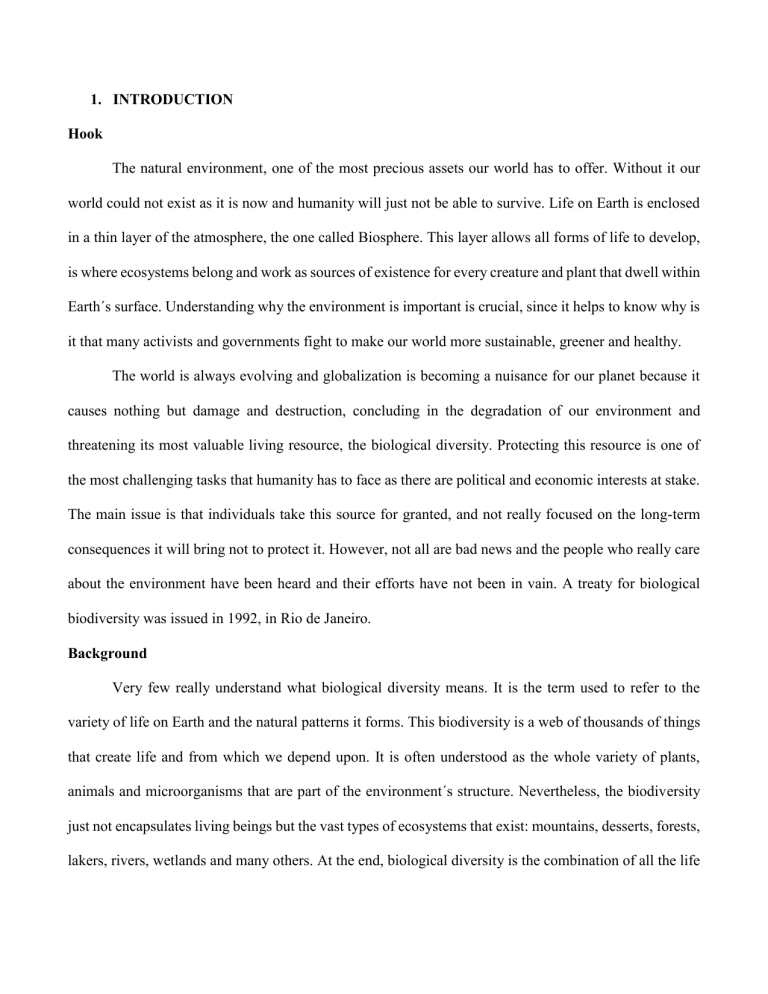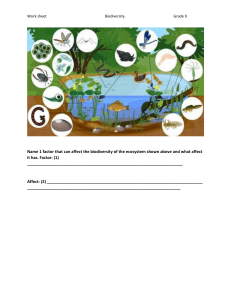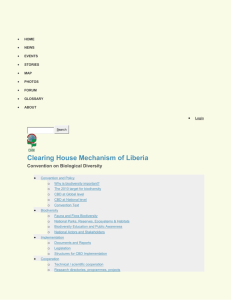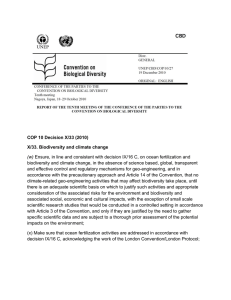
1. INTRODUCTION Hook The natural environment, one of the most precious assets our world has to offer. Without it our world could not exist as it is now and humanity will just not be able to survive. Life on Earth is enclosed in a thin layer of the atmosphere, the one called Biosphere. This layer allows all forms of life to develop, is where ecosystems belong and work as sources of existence for every creature and plant that dwell within Earth´s surface. Understanding why the environment is important is crucial, since it helps to know why is it that many activists and governments fight to make our world more sustainable, greener and healthy. The world is always evolving and globalization is becoming a nuisance for our planet because it causes nothing but damage and destruction, concluding in the degradation of our environment and threatening its most valuable living resource, the biological diversity. Protecting this resource is one of the most challenging tasks that humanity has to face as there are political and economic interests at stake. The main issue is that individuals take this source for granted, and not really focused on the long-term consequences it will bring not to protect it. However, not all are bad news and the people who really care about the environment have been heard and their efforts have not been in vain. A treaty for biological biodiversity was issued in 1992, in Rio de Janeiro. Background Very few really understand what biological diversity means. It is the term used to refer to the variety of life on Earth and the natural patterns it forms. This biodiversity is a web of thousands of things that create life and from which we depend upon. It is often understood as the whole variety of plants, animals and microorganisms that are part of the environment´s structure. Nevertheless, the biodiversity just not encapsulates living beings but the vast types of ecosystems that exist: mountains, desserts, forests, lakers, rivers, wetlands and many others. At the end, biological diversity is the combination of all the life forms that live on Earth and how their interact with their natural surroundings (How the Convention on biological diversity promotes nature and human well-being, 2000). This diversity needed to be protected at all cost, so in 1992 an official treaty was issued. It is the collective work of many people and institutions that has allowed the agreements on biological diversity to work. Many actors from a whole bunch of categories have worked and are working to make preserve the resource. For an instance two main protagonists are the main actors of this initiative: the governmental organization that regulate biodiversity on each country and the Convention for Biological Diversity (CBD), which is the main entity on the equation (Actors of the United Nations Decade on Biodiversity, 2021). According to Kok et al. (2020), there are also some other actors that play from small to large roles on the implementation of the treaty. One of the secondary characters are the local governments, the ones that help to take actions on the local and regional scale. The ICLEI – Local Governments for Sustainability is a global network of local and regional governments that has supported natural-based solutions in cities for years, and all this thanks to a was range of sustainable programmes and international efforts that promote the learning, experimenting, cooperation, monitoring and the transparency of biodiversity-related initiatives. Third parties that support biodiversity are also part of the process. The ISEAL alliance is an example of this, a party that works with the Voluntary Sustainability Standards (VSS). This alliance is a community of people and an organization that focuses on change by improving the impacts of ambitious sustainability systems. ISEAL works toe to toe with governments and even allow them to be part of its members; it promotes the use of good governmental practices that could meet the VSS. Not only governments work with ISEAL but tons of institutions and companies do as well, and this because awareness of biological diversity increases and the social, political and economic impact is beneficial for the members of the alliance. Private sector is a key actor for the survival of biodiversity. For the sustainable initiatives to take place, there is definitely a need for money. Governments, third parties and main institutions related to the cause can raise funds to work on biological biodiversity, however, sometimes it is not enough. This is where the private sector fulfills an important role due to the aid it offers, in the form of investments for environmental-friendly and nature-oriented practices. An organization, the Natural Capital Coalition (NCC), was created in 2012 by businesses, civil society and the World Bank, all with the aim to benefit the amount of capital destined for the protection of biodiversity. Several years had to pass for the treaty to officially be part of the policies for biodiversity of associated countries. The extinction of species and the destruction of ecosystems was alarming during the 80s, that is why the United Nations Environment Programme (UNEP) started what is considered the initial phase of this international agreement. In 1988 a group of biological diversity experts joined together to assess the need for an international convention for biological diversity. Soon after, in May 1989, a group of technicians and legal experts prepared an international legal instrument for the conservation and sustainable use of biological diversity. In November 1990 a new session was held, where the costs, the needs, the participants, the legal requirements and considerations where discussed (History of the convention, 2023). Right after the third session concluded, the negotiation phase started. By February 1991 the Ad Hoc working group that was already settled and became to be known as the Intergovernmental Negotiating Committee. During the session (the second session of negotiations) four main issues where covered: the first concerned the fundamental principle that the conservation of biological diversity was a matter of all people, this meant that the participation a global partnership was necessary. The second issue concerned financial mechanisms; the funding of the initiative was discussed. Third issue concerned the availability and access to biological resources and technology to ensure the protection on biodiversity. Last and fourth issue concerned the need to ensure the participation of developing countries in the negotiations (Report of the Ad Hoc Working Group of legal and technical experts on biological biodiversity on the work of its second session, 1991). A third session for negotiations was held in July 1991 where similar topics where discussed; no report on this session was found. There were up to seven negotiation sessions before the adoption of the convention took place. May 1992, as agreed in the final negotiating session, the conference bureau decided to accept the text proposed article by article. Any resolutions submitted by the delegations of the bureau were adopted and the final act was signed by the members of the committee. The session was named as Nairobi Conference for the Adoption of the Agreed Text of the Convention on Biological Diversity (United Nations Environment Programme, 1992). The authentication stage finally could take place and The Convention meant to issue the treaty, was opened for signature. This was the Convention for Biological Biodiversity, held on June 5, 1992 in Rio de Janeiro, Brazil. It remained open for signature until June 1993; 198 countries agreed on the treaty and signed for the subscription to the convention. Finally, the Convention entered into force on December 29, 1993. The objectives for the Convention and treaty were and continue to be clear. They are as follows: the conservation of biological diversity, the sustainable use of biological diversity, the fair and equitable sharing of the benefits arising out of the utilization of genetic resources (The United Nations Convention on Biological Diversity 2022). Goals to achieve for the countries, third parties, private sector, institutions are set and is their job to accomplish every single one of them, if not all the efforts and negotiations done in the past will be for nothing. At the end of the day, the main goal of this treaty aims to protect the natural environment from all the hazards and threats that humankind puts over the biodiversity. The convention was not only designed to aid the Earth, but to raise awareness over all the governments, institutions, companies and business, and most importantly in each of the world’s individuals. The Convention on Biological Diversity (CBD) is leading the world to a renewed era due to all the economic, legal-political and environmental good impacts that have been brought out to the table. 2. BODY First Event Initiatives that don’t have demonstrable economic and financial benefits, are unlikely to be supported at all. Of course, some people voluntarily will support a cause with no desires for profit, but most of the individuals, industries, businesses and companies need to ensure that supporting something is rewarding to them, in the sense of money. Most people will do as they please if it is profitable for them, no matter the cost or the consequences of doing it. Without an economic incentive, many of the actors related to the treaty will just not be motivated towards working according to the biodiversity-oriented practices and activities. That is why the CBD had to sort a way to keep not only activists and biodiversityrelated institutions happy, but to attract private sector investors as well as other profit-oriented entities. The Article 11 of the treaty mentions the incentives for the contracting parties as follows: “… as far as possible adopt economically and socially sounded measures that act as incentives for the conservation a sustainable use of components of biological diversity…” (Convention on Biological Diversity, 1992). Just like the articles says, the convention took into consideration that the contracting parts would need adequate motivation to act upon biodiversity. Constanza et al. (2014) studies showed that biodiversity promotion is indispensable as it provides a whole number of services at local, regional and even global scale. Protecting ecosystems and animal/microorganisms allow the production of food, the purification of consumable water, flood protection and most importantly the mitigation of climate change. Constanza’s group estimated that all of these services suppose a gigantic value of 125-140 trillion US dollars in 2011. Even though they are speculative results, they help to understand how important is the economic value of the treaty. On the other side, Newman and Cragg (2016) explored the need to preserve the biodiversity, since it helps industries in lots of fields. Many products are generated from natural extracts that come from the ecosystems and animals that are threatened by humankind. Protecting these sources of raw materials help the pharmaceutical, food or other industries to survive, expand and be profitable. So, ultimately it is a winwin transaction between the two parts, the contracting one (companies, industries, businesses) and the demanding one (activists, governmental organizations, biodiversity-oriented third parties). Second Event The CBD for an instance could be seen as an effort concerning only the governments that are subscripted, but that it is not the case due to all the actors that take part of the initiative. However, it is clear that politics and law play key roles in the development of biodiversity-oriented practices. From the beginning, there was the need for political institutions to be part of the CBD, and that is how it all started, with a political organization. All the cooperation between countries brought a political bridge that could start a political global system that could sustain the treaty. The country members had to expand their mindset in regard to the way politics revolve around national interests and also broaden the conception of national wealth to one that accounts for the Earth’s natural assets, living beings and ecosystems. All of this was possible by working in conjunction with the law, the convention just would have never occurred if not for the legal foundations. New regulations and laws have to be applied, the governments had to strengthen the institutional and legal foundations to new ones meant to support international environmental cooperation. Article 8 is a good example of how law exerts its influence over the treaty: “…develop and maintain necessary legislation and/or other regulatory provisions for the protection of threatened species and populations”. The legal department that helped to develop the official text for the convention had to ensure a way to create a regulatory system by which the contracting parties could work on the basis of strict regulations that benefit the biodiversity. These regulations have helped to motivate, if not force, the parties to act upon the framework of a biodiversity-friendly legislation. Bodansky in 1995 mentioned that the environmental international law created during the CBD had to be designed to “allow the countries where biological resources are found to realize or recapture some of the value of those resources, and thereby provide them an incentive to engage in conservation”. He says that the CBD succeeded compared to previous attempts to aid biodiversity, in that it went beyond; the convention took a more comprehensive approach, including access to biological resources, biotechnology and financial support. According to Bodansky “contractural obligations” are the source of international law regarding biodiversity. These obligations he mentions are some sort of agreements that don’t work only between countries, but between countries and private enterprises. These obligations have two types of contractural undertakings, “debt for nature swaps” under which the country or company engage into biodiversity conservation in exchange of the cancelation of a foreign or local debt. The second one, “access agreements” which imply that countries make their biological resources available to others in exchange of money or technology. After all, international law is been exerted in an environmental framework that not only incentives countries and business, but allows biodiversity-oriented practices to emerge. Third Event The environment, the one that has been benefitted the most by the treaty. It has been already discussed, the CBD was created to protect and preserve biodiversity. Most of the articles presented in the legal instrument revolve around the conservation of biological diversity, so it was kind of obvious that the good impacts were going to be focused over the nature and environment. An extract from article 7 says “each contracting party shall…identify processes and categories of activities which have or are likely to have significant adverse impacts on the conservation and sustainable use of biological diversity…”. The article is clear, no practices that could harm the environment should be considered as good for the preservation of biodiversity. Other articles also include matters regarding the environmental health, such as the article 9, from which a passage of it indicates: “each contracting party shall…adopt measures for the recovery and rehabilitation of threatened species…”. With these examples it becomes more than clear that CBD was meant to produce a significant amount of positive impact on the environment and its assets. Many are the examples that have shown the scope the CBD has had concerning the environment. It is simply the epitome of environmental agreements and it brings the best benefits for the preservation and restoration of nature’s ground. The European Commission links the effort of maintaining a sustainable use of biodiversity with the mitigation of climate change. A group of Brazilian researchers remark that the CBD has allow to raise awareness in local and regional governments, towards the implementation of practices thar preserve biodiversity. For example, their study demonstrated that from the creation of the treaty to this day, the number of protected areas has been growing (Puppim de Oliveira et al., 2011). Morgera et al. (2011), pointed out that even though the treaty has not even the most effective one and has been criticized a lot, it still has helped to progress into sustainable and preserving era. In the long run, the CBD and the treaty attached to it has done some good to Earth’s health and it is clearer than ever that a change for good is happening. 3. Conclusion Summary Biological diversity or just biodiversity, a network that provides the resources for life to exist. Many attempts were made to have a global system that could aid on the preservation of biodiversity. It was not until 1992, where something changed, the Convention on Biological Biodiversity took place in Rio de Janeiro. This was the first moment a cooperative effort had succeeded in bringing up a feasible way to promote the production of natural and environmental assets. A legal instrument was issued and 198 countries signed to be part of the initiative. Financial, political, biological, technological and legal aspects were all considered on the treaty brought by the convention. In 1993 the CBD was put into force and from there on the world has been adapting and evolving towards an era of sustainability. Importance of topic It is of major importance that a treaty like this exists. The environmental assets are not the only ones that get benefits form it. A clear impact over economies at local, regional and global scale has occurred. The treaty ensured that the contracting parties were happy, and that is why by all means some of the articles from the legal instrument state that there should be ways to offer incentives, financial motivation that could make the actors on this scenario to be interested. Legal-political impacts have also been noticed. Many governmental institutions have emerged and politics have evolved into a new mindset where the national, local and regional interests could focus more on the maintenance of nature’s assets, living organisms and ecosystems. In regards of legal impact, the environmental international law has been changed forever with the appearance of the CBD. The implementation of regulations and legislations that mainly deal with biodiversity issues had never worked until the treaty on biological diversity was created. It just not changed that way laws were exerted but it went beyond, something that previous attempts were not capable of. Closing statement Probably the CBD and the treaty that came with it are not the most effective way to deal with the destruction of the natural resources and assets, but as discussed throughout the entirety of this text, the way the politics, law, economy and environment have been benefitted is absolutely and undoubtedly true. The CBD has done its part of leading the world to a new era, one where the cooperative global effort can achieve a goal, the goal to preserve and conserve biodiversity. 4. References 1. Actors of the United Nations Decade on Biodiversity. (2021). Retrieved March 23, 2023, from https://www.cbd.int/2011-2020/actors 2. History of the convention. (2023, March 14). Retrieved March 27, 2023, from https://www.cbd.int/history/ 3. How the Convention on Life on Earth sustaining. (2000, April). Retrieved March 23, 2023, from https://www.cbd.int/doc/publications/cbd-sustain-en.pdf 4. Report of the Ad Hoc Working Group of legal and technical experts on biological biodiversity on the work of its second session. (1991). Retrieved March 27, 2023, from https://www.cbd.int/doc/meetings/iccbd/bdn-02-awg-02/official/bdn-02-awg-02-02-en.pdf 5. Secretariat of the Convention on Biological Diversity. (2021). Living in harmony with nature. Retrieved March 27, 2023, from https://www.cbd.int/2011-2020/actors 6. United Nations Environment Programme. (1992, May). Conference for the adoption of the Convention of Biological Biodiversity. Retrieved March 27, https://www.cbd.int/doc/meetings/iccbd/bdconf/official/bdconf-01-add1-en.pdf 2023, from 7. Costanza, R., De Groot, R., Sutton, P., Van der Ploeg, S., Anderson, S. J., Kubiszewski, I., . . . Turner, R. K. (2014). Changes in the global value of Ecosystem Services. Global Environmental Change, 26, 152-158. doi:10.1016/j.gloenvcha.2014.04.002 8. Newman, D. J., & Cragg, G. M. (2016). Natural products as sources of new drugs from 1981 to 2014. 9. Journal of Natural Products, 79(3), 629-661. doi:10.1021/acs.jnatprod.5b01055 10. Bodansky, D. M. (1995). International Law and the Protection of Biological Diversity. Vanderbilt Journal of Transnational Law, 28(4). 11. Morgera, E., & Tsioumani, E. (2010). Yesterday, Today, and tomorrow: Looking afresh at the convention on biological diversity. Yearbook of International Environmental Law, 21(1), 3-40. doi:10.1093/yiel/yvr003



